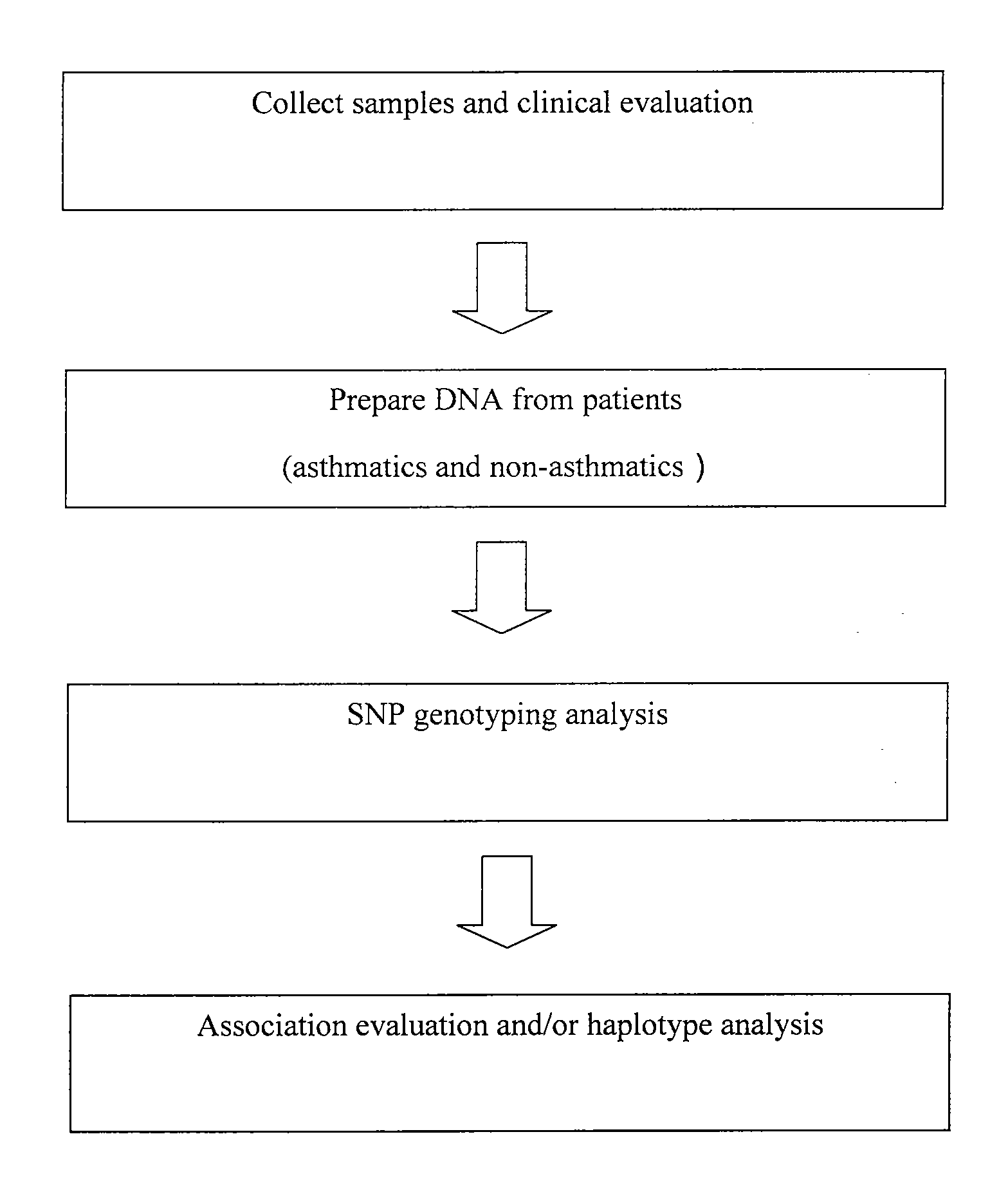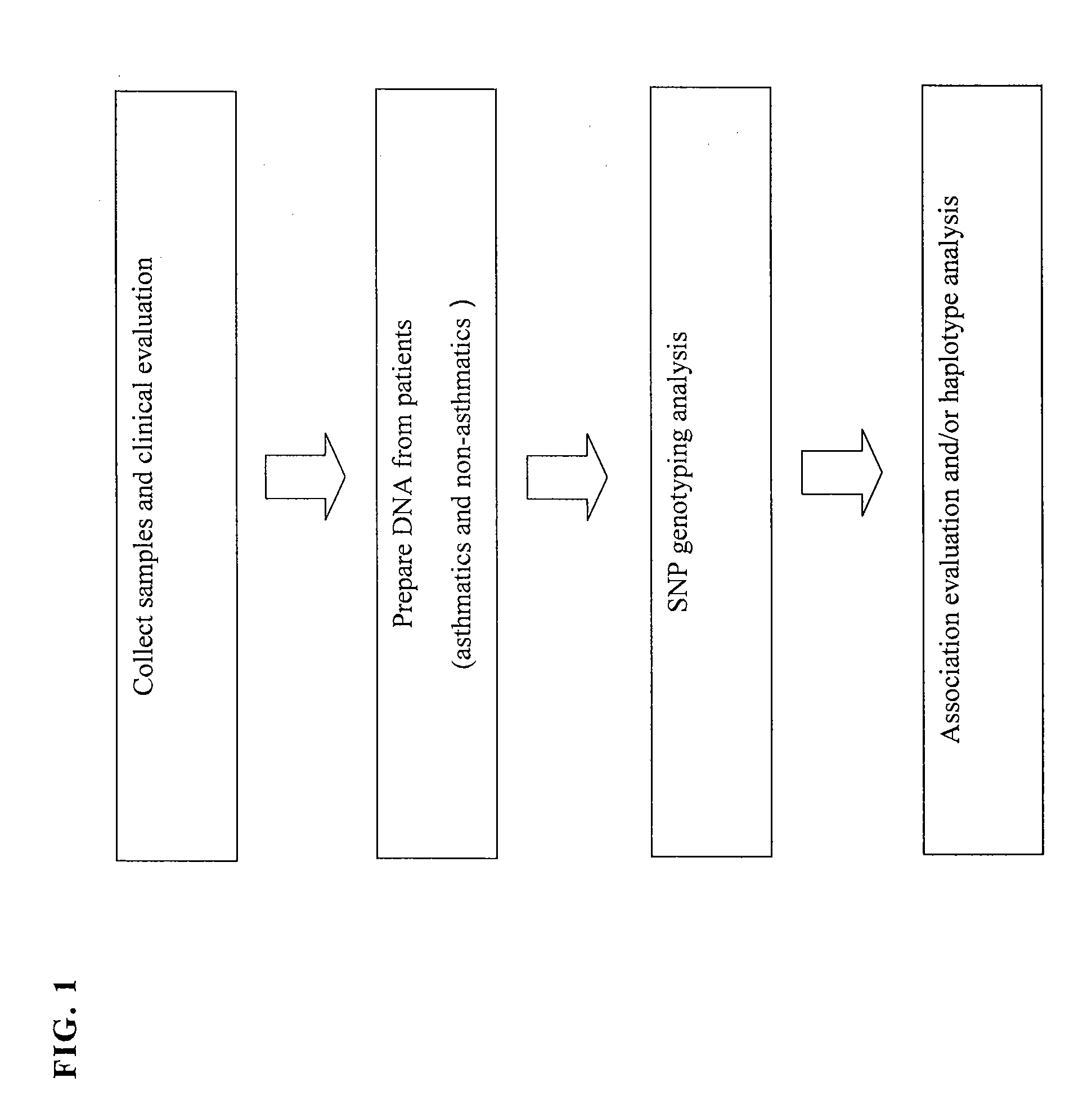Single Nucleotide Polymorphisms in Protein-Tyrosine Phosphatase Receptor-Type Delta for the Diagnosis of Susceptibility to Infection and Asthma
a protein-tyrosine phosphatase and receptor-type technology, applied in the field of protein-tyrosine phosphatase receptor-type delta (ptprd) gene, can solve the problems of increased hospitalization and possibly death, asthma development, and people whose relatives suffer from asthma
- Summary
- Abstract
- Description
- Claims
- Application Information
AI Technical Summary
Benefits of technology
Problems solved by technology
Method used
Image
Examples
example 1
Study Population
[0029]A population of 1000 asthmatic children between 1 to 12 years old was analyzed. “Asthma” was diagnosed through the three following conditions: (1) History of wheezing and shortness of breath with or without respiratory infections; (2) Chronic cough for more than one month and / or one or more wheezing episodes in the presence of a physician; and (3) Bronchodilator test with a positive increase of 15% for FEV1.
[0030]Other evaluations included skin prick tests for responsiveness to 6 common aeroallergens, a differential blood count (including total eosinophil count), and measures of total serum IgE, as well as IgE specific to house dust and mixed pollens using UNICAP™ system (PHARMACIA DIAGNOSTIC™, Sweden). A positive skin test was defined as the presence of≧1 reaction with a wheal diameter≧5 mm. Total serum IgE was measured by solid-phase immunoassay (PHARMACIA™ IgE EIA).
[0031]The study protocol was approved by the Ethical and Clinical Trial Committee of National ...
example 2
[0032]Genomic DNA was extracted from blood samples for 1000 children using QIAAMP™ DNA Blood kit (QIAGEN) by following the manufacture's instructions. The extracted genomic DNA was confirmed by agarose gel electrophoresis analysis, quantified by spectrophotometer, and stored at −80° C. until use.
[0033]All SNP genotypes were analyzed using the TAQMAN® SNP genotyping assays (APPLIED BIOSCIENCES™) and 1 to 20 ng of purified genomic DNA. 2×TAQMAN® Universal PCR Master Mix, without AMPERASE® UNG, and 20×SNP Genotyping Assay Mix were used, wherein the SNP Genotyping Assay Mix contained: (1) sequence-specific forward and reverse primers to amplify the SNP of interest (See Table IV for primer sequences); and (2) two TAQMAN® MGB probes labeled with VIC™ dye for Allele 1 and FAM™ dye for Allele 2. The reaction mixture was PCR amplified and an endpoint measurement was used to detect each allele.
[0034]Specifically, reaction mix was prepared by gently resuspending 2×TAQMAN® Uni...
example 3
Alternate Sample Preparation
[0037]In another embodiment of the invention, the genotyping of a patients PTPRD gene was conducted by SNAPSHOT™, wherein each reaction contained 2.5 μl of 10×Reaction Buffer, 0.5 μl of 10 mM dNTPs, 2.5 μl 25 mM MgCl2, 16.375 μl sterile deionized water, 1.0 μl primer pair (5 μM each primer), 1 μl genomic DNA (10 ng) and 0.125 μl of 5 U AmpliTaq Gold® for a total reaction volume of 25 μl / well. Amplification and the fluorescence signal detection were performed using an ABI prism 7900 Real-Time PCR System™ with following conditions: One cycle at 94° C. for 12 minutes, 35 cycles of melting at 94° C. for 30 seconds, annealing at 58° C. for 45 seconds, extending 72° C. 1 minute, 1 cycle at 72° C. for 10 minutes and hold on 4° C.
[0038]The amplification was followed by Exo-SAP™ reaction whereby Shrimp Alkaline Phosphatase (SAP) dephosphorylates residual deoxynucleotides preventing them from participating in sequencing reactions, and Exonuclease I degrades excess ...
PUM
| Property | Measurement | Unit |
|---|---|---|
| volume | aaaaa | aaaaa |
| total volume | aaaaa | aaaaa |
| volume | aaaaa | aaaaa |
Abstract
Description
Claims
Application Information
 Login to View More
Login to View More - R&D
- Intellectual Property
- Life Sciences
- Materials
- Tech Scout
- Unparalleled Data Quality
- Higher Quality Content
- 60% Fewer Hallucinations
Browse by: Latest US Patents, China's latest patents, Technical Efficacy Thesaurus, Application Domain, Technology Topic, Popular Technical Reports.
© 2025 PatSnap. All rights reserved.Legal|Privacy policy|Modern Slavery Act Transparency Statement|Sitemap|About US| Contact US: help@patsnap.com


